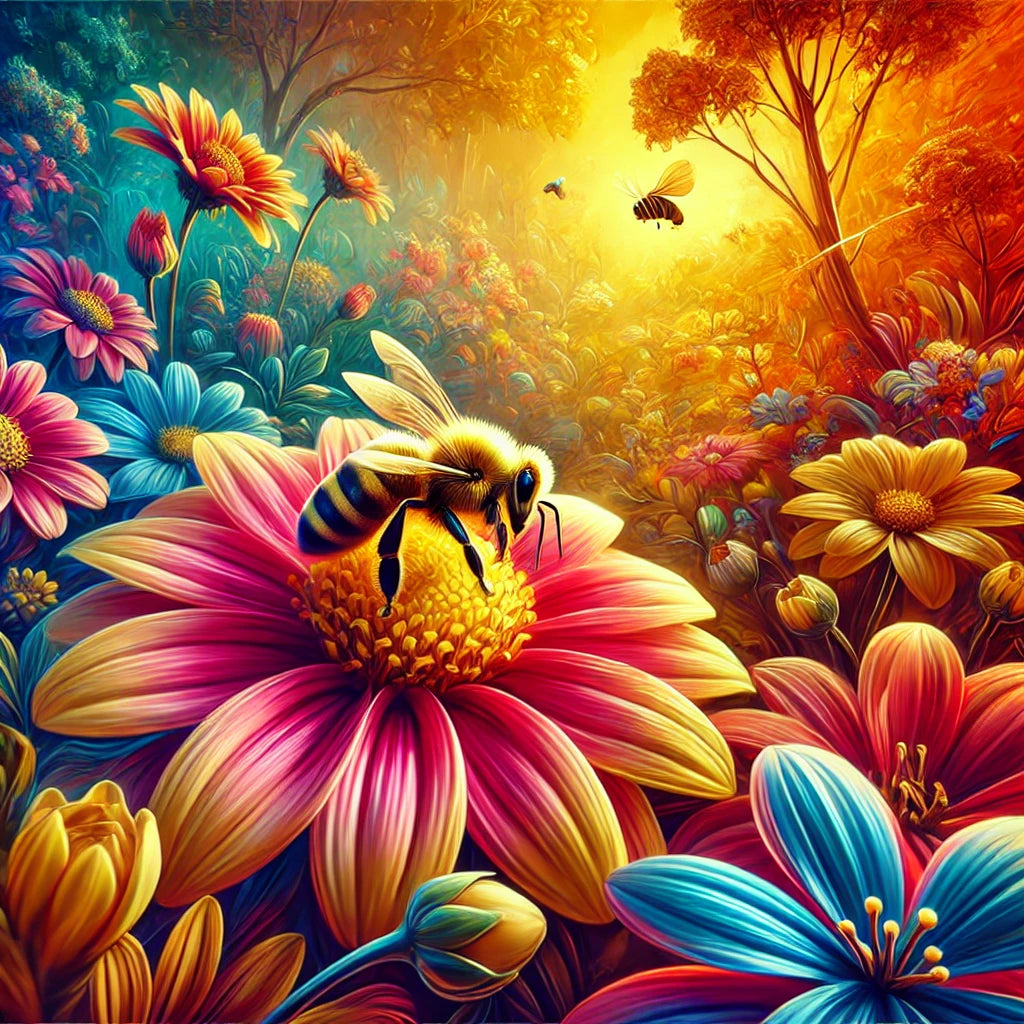The synergy between honey bees and flowers is vital for both honey production and pollination. Every time a honey bee lands on a flower, it collects nectar and pollen, both critical to the bee’s nutrition and honey-making process. Flowers rely on bees for pollination, leading to plant reproduction and diversity. This mutually beneficial relationship is the foundation of healthy ecosystems and abundant honey.
How Bees and Flowers Work Together
When a honey bee visits a flower, it’s not just gathering food for the hive. It also transfers pollen from flower to flower, ensuring cross-pollination. This process is essential for plant reproduction and contributes to the life cycle of bees as it provides bees with the nutrients needed to support their hives. Pollination by bees helps increase the yield of fruits, nuts, and vegetables, which is critical for agriculture.
The Role of Flowers in Honey Production
Flowers serve as the primary food source for bees, offering nectar that bees convert into honey. Different flowers produce various types of honey, with some flowers contributing to the distinct flavors of honey. Bees need access to abundant floral sources throughout the season to produce large quantities of honey. For new beekeepers looking to expand their hives, understanding the best flowers for honey production is essential for ensuring strong honey yields.
Choosing the Best Flowers for Honey Bees
Selecting the right flowers for bees is crucial for both honey production and hive health. Bees are particularly attracted to flowers with high nectar content, such as lavender, sunflowers, and clover. These plants provide ample nutrition for bees and ensure they can produce honey efficiently.
Beekeepers can optimize their hives by planting a diverse range of flowers to support bees throughout the year. If you're establishing your first hive and want to enhance productivity, learn more about how to start a bee farm to make sure your bees have the best environment.
Pollination and Its Impact on Agriculture
Bees are some of the most efficient pollinators, playing a critical role in global food production. By pollinating crops, bees contribute to the growth of fruits, nuts, and vegetables. Without them, many agricultural systems would struggle to produce sufficient food.
This essential service emphasizes why honeybees are so vital to agriculture. By supporting bee populations, farmers and beekeepers ensure a steady supply of food for the world.
Swarming: A Natural Bee Behavior
Swarming is a natural phenomenon where part of a bee colony leaves to start a new hive. Although it can be alarming for new beekeepers, swarming is a sign of a healthy, thriving colony. Proper management of swarming ensures that the remaining bees continue producing honey.
Beekeepers can manage swarming by ensuring enough space in the hive and employing other methods such as checkerboarding or splitting hives. Learn more about how to manage honey bee swarms to maintain a productive colony.
Managing Hive Locations and Relocation
Beehive location plays a significant role in a hive’s success. If a hive becomes overcrowded or located in an area with poor floral sources, bee hive relocation may be necessary. Relocating a hive properly ensures the bees can continue foraging in a healthier, more productive environment. Beekeepers should monitor their hives and consider relocation if they notice reduced honey production or limited forage in the current location.
Enhance Your Hive with Swarm Commander
The connection between honey bees and flowers is fundamental to honey production and ecosystem health. By planting the right flowers, managing bee populations, and understanding their natural behaviors, beekeepers can enhance honey production and contribute to global agriculture. Products from Swarm Commander, such as bee trap attractants, help support and maintain strong, healthy bee populations.
Equip your hive for success with Swarm Commander’s range of tools, from bee trap attractants to protective gear, ensuring your bees have the best environment for productivity and health.
Frequently Asked Questions About Honey Bee on Flower
Q1. What are the best flowers for honey production?
Some of the most effective flowers for honey production include lavender, clover, and sunflowers. Bees are naturally attracted to these plants due to their high nectar content, which helps increase honey yields.
Q2. How do bees contribute to agriculture?
Bees play a crucial role in pollinating a significant portion of the crops we consume, including fruits, nuts, and vegetables. Without their contribution, many agricultural systems would struggle to produce enough food.
Q3. What should I do if my hive swarms?
Swarming is a natural process where bees leave the hive to form a new colony. You can manage swarming by providing enough space for the bees and using techniques like checkerboarding or splitting hives.
Q4. Can relocating my hive improve honey production?
Yes, if your hive is located in an area with limited floral sources, bee hive relocation can help ensure that bees have access to better foraging options, which can boost honey production.
Q5. How do I start my own bee farm?
Starting a bee farm requires knowledge of bee behavior, optimal hive locations, and the right equipment. Learn more about how to start a bee farm to ensure you’re setting up your bees for success.



